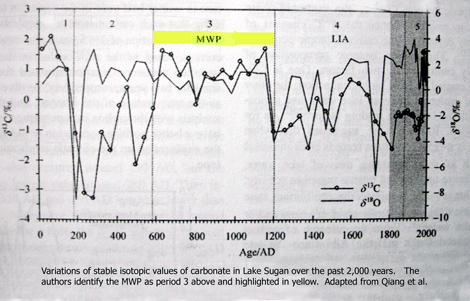Lake Sugan, Northeastern Tibetan Plateau, China
Reference
Qiang, M., Chen, F., Zhang, J., Gao, S. and Zhou, A. 2005. Climatic changes documented by stable isotopes of sedimentary carbonate in Lake Sugan, northeastern Tibetan Plateau of China, since 2 kaBP. Chinese Science Bulletin 50: 1930-1939.
Reference
Qiang, M., Chen, F., Zhang, J., Gao, S. and Zhou, A. 2005. Climatic changes documented by stable isotopes of sedimentary carbonate in Lake Sugan, northeastern Tibetan Plateau of China, since 2 kaBP. Chinese Science Bulletin 50: 1930-1939.
Description
Stable carbon isotope analyses were conducted on sediment cores taken from Lake Sugan (38°51.19'N, 93°54.09'E), located in the northeastern region of the Tibetan Plateau to produce a proxy of winter temperatures over the past 2,000 years. The results indicated a warm and dry period between 580 and 1200 AD, which they state "corresponds to the Medieval Warm Period." A view of the data in the author's Figure 3 reveals the MWP was probably at least as warm between ~AD 1100 and 1200 as it is presently .





